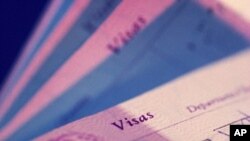Anyone attempting to visit the United States as a student, businessman or tourist knows that getting a visa can take weeks or months, and involve several visits to a U.S. embassy or consulate. U.S. officials say they are aware of the need to improve visa and other services for visitors, and that they are making concerted efforts toward that end.
At a time of weak economic growth and fiscal austerity, Democratic Senator Amy Klobuchar of Minnesota says America cannot afford to take tourists and other foreign visitors for granted.
"This is about jobs. Each foreign visitor to our country spends an average of $4,000,” Klobuchar said. “We are talking about some serious money. In 2009 alone, spending by overseas visitors supported some 900,000 American jobs, and paid $23 billion in wages to American workers."
Klobuchar is Chairwoman of the Senate Commerce Subcommittee on Competitiveness, Innovation, and Export Promotion. She says that from 2000 to 2009, America’s share of global tourism fell by almost a third, costing the country hundreds of billions of dollars in lost revenue and hundreds of thousands of jobs.
Last year, President Barack Obama signed into law the Travel Promotion Act, which set up a public-private partnership to attract more visitors to the United States. At a hearing last week, Klobuchar said the initiative can work only if U.S. visa-granting procedures are improved.
"It doesn’t do much good to promote the U.S. to foreign travelers when those foreign travelers can’t get a visa for months to visit the United States of America. In a recent survey, 73 percent of respondents said they would not visit the U.S. if they knew it would take them two-to-three months to get a visa,” Klobuchar stated. “Well, sadly, in several countries, that is how long it is taking."
U.S. officials testifying before the subcommittee spoke of efforts to expedite visa applications and boost consular staffing levels. They also pointed to a growing number of countries, currently three dozen, taking part in a visa waiver program that eliminates the need for a U.S. visa for many types of travel.
The State Department’s Deputy Assistant Secretary for Visa Services, David Donahue, says these efforts have helped reverse the decline in the number of foreign visitors to the United States.
"In 2010, 60 million international visitors entered the United States -- a 17 percent increase from 2006. Demand for visas climbed at a dramatic pace in the world’s fastest-emerging economies. Since 2005, visa issuance in China has doubled, and increased by 50 percent in India, 52 percent in Russia, 24 percent in Mexico, and more than 50 percent in the Middle East and North Africa. In Brazil, visa issuance has nearly tripled," Donahue explained.
But Donahue added that the need for prompt visa processing must be balanced against America’s need to scrutinize everyone entering the country following the 2001 terrorist attacks on New York and Washington. For instance, he noted that some have suggested adopting video conferencing technology so that U.S. officials can interview visa applicants from afar, rather than forcing them to visit U.S. consulates. Donahue said that from a security standpoint, that idea is ill-advised.
"The purpose of the in-person interview is to really assess the person standing in front of you and make a determination whether they are going to use the visa properly," he explained. "And in a two-dimensional Skype-type situation, even with the best technologies, we do not believe we will be able to make those decisions. It is a three-dimensional live presence that we feel is important."
To reduce aggravation and delays after visitors arrive in the United States, the former Bush administration established a "Model Ports of Entry" program. Under the program, additional Customs and Border Protection officers have been deployed to the nation's busiest international airports. Inspection areas have been revamped to make them more welcoming, and express lanes have been established for arriving visitors who need to make connecting flights.
US Congress Examines Visa Procedures





